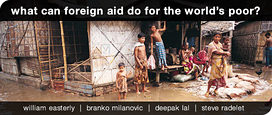In his response, Dr. Easterly uses an old tactic: he creates fictitious positions and attributes them to me, then attacks them. Just to set the record straight before getting on to more interesting substance: He claims I said that aid “accomplishes miracles of raising growth.” I actually wrote that “aid has achieved very modest results in many places, strong results in a few, and failure in others.” I also said that those that claim miracles are just as wrong as those that claim total failure. He claims I say that “aid is doing just fine” when I wrote that “aid programs are not nearly as effective as they could be, much is wasted, and we can and must do better.” He claims that in my own study “the most aid-intensive countries have a zero or even negative effect of additional aid on growth;” in fact we find nothing of the sort—there are no such outcomes in our study. He claims I use data points to selectively make my case, when in fact I wrote both about aid failures (the Democratic Republic of Congo, Haiti, the Philippines, and others) as well as its successes (Mozambique, Uganda, Korea, Botswana, the latter of which were low income countries when the received the bulk of their aid, not middle income as Dr. Easterly claims). And on it goes with each point in his response.
But enough of that; on with the substance. One reason why some studies have had difficulty in identifying an aid-growth relationship is that they assume that all aid must affect growth in an identical way. But in the real world this makes little sense. Food and humanitarian aid are aimed primarily at supporting basic consumption, not growth, as is the provision of medicines, bed nets, and school books. Aid to support democracy or judicial reform is not primarily aimed at stimulating growth. So in our research we recognize these differences and break aid flows into three separate categories.
The first group is aid for disasters, emergencies, and humanitarian relief efforts, including food aid. It turns out that this kind of aid has a negative relationship with growth, since a disaster simultaneously causes growth to fall and aid to increase. The Asian tsunami caused extensive damage and undermined economic growth, and donors responded with substantial increases in aid. The fact that aid went up when growth went down is obviously not because aid failed, but it looks like a negative relationship in simple studies.
The second category is aid that might affect growth, but if so, only indirectly and over a long period of time. Aid to halt environmental degradation, support democratic or judicial reform, or for childhood immunizations might affect growth, but it will take a long time and will be very hard to detect. Sure enough, it is very hard to detect a statistical relationship between this type of aid and growth, one way or the other.
The third category is aid aimed more directly at economic growth: for roads, irrigation systems, electricity generators, ports, agriculture, industry, trade, and similar activities. It turns out that this type of aid (about half of all flows) has a robust positive relationship with growth. It is no miracle cure: the rates of return average in the modest neighborhood of 13%. And it does not mean that this type of aid has worked everywhere: for some countries the relationship is stronger, and in others it is weaker. But on average there is a modest, positive, statistically significant relationship.
The real world is a messy place, and the truth does not fit into nice neat categories like “aid has failed” or the other extreme of “aid accomplishes miracles.” It gets messier when we try to force all aid into a single relationship. An even-handed review of the evidence suggests that aid (especially aid actually aimed at growth) has achieved modest results in many places, strong results in a few, and failure in others, and has contributed to improved health in many countries. The humble positive track record leaves substantial room for improvement. This evidence does not lend itself well to simplistic sound bites, but it accurately reflects the world.
The real challenge, then, is to move beyond the rhetoric and figure out how to build on the successes, learn from the failures, and make aid more effective going forward. And as I said in my first note, Dr. Easterly’s suggestions for greater feedback, accountability, and measurable results are a good place to start.

